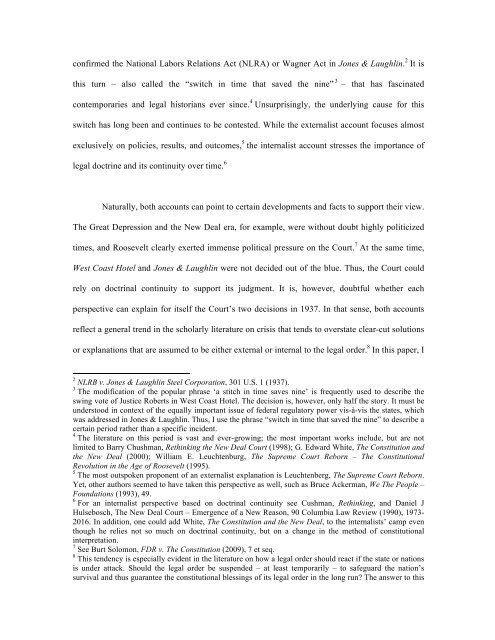Jasper Finke, Crisis and Law - New York University School of Law
Jasper Finke, Crisis and Law - New York University School of Law
Jasper Finke, Crisis and Law - New York University School of Law
Create successful ePaper yourself
Turn your PDF publications into a flip-book with our unique Google optimized e-Paper software.
confirmed the National Labors Relations Act (NLRA) or Wagner Act in Jones & Laughlin. 2 It is<br />
this turn – also called the “switch in time that saved the nine” 3 – that has fascinated<br />
contemporaries <strong>and</strong> legal historians ever since. 4 Unsurprisingly, the underlying cause for this<br />
switch has long been <strong>and</strong> continues to be contested. While the externalist account focuses almost<br />
exclusively on policies, results, <strong>and</strong> outcomes, 5 the internalist account stresses the importance <strong>of</strong><br />
legal doctrine <strong>and</strong> its continuity over time. 6<br />
Naturally, both accounts can point to certain developments <strong>and</strong> facts to support their view.<br />
The Great Depression <strong>and</strong> the <strong>New</strong> Deal era, for example, were without doubt highly politicized<br />
times, <strong>and</strong> Roosevelt clearly exerted immense political pressure on the Court. 7 At the same time,<br />
West Coast Hotel <strong>and</strong> Jones & Laughlin were not decided out <strong>of</strong> the blue. Thus, the Court could<br />
rely on doctrinal continuity to support its judgment. It is, however, doubtful whether each<br />
perspective can explain for itself the Court’s two decisions in 1937. In that sense, both accounts<br />
reflect a general trend in the scholarly literature on crisis that tends to overstate clear-cut solutions<br />
or explanations that are assumed to be either external or internal to the legal order. 8 In this paper, I<br />
2 NLRB v. Jones & Laughlin Steel Corporation, 301 U.S. 1 (1937).<br />
3 The modification <strong>of</strong> the popular phrase ‘a stitch in time saves nine’ is frequently used to describe the<br />
swing vote <strong>of</strong> Justice Roberts in West Coast Hotel. The decision is, however, only half the story. It must be<br />
understood in context <strong>of</strong> the equally important issue <strong>of</strong> federal regulatory power vis-à-vis the states, which<br />
was addressed in Jones & Laughlin. Thus, I use the phrase “switch in time that saved the nine” to describe a<br />
certain period rather than a specific incident.<br />
4 The literature on this period is vast <strong>and</strong> ever-growing; the most important works include, but are not<br />
limited to Barry Chushman, Rethinking the <strong>New</strong> Deal Court (1998); G. Edward White, The Constitution <strong>and</strong><br />
the <strong>New</strong> Deal (2000); William E. Leuchtenburg, The Supreme Court Reborn – The Constitutional<br />
Revolution in the Age <strong>of</strong> Roosevelt (1995).<br />
5 The most outspoken proponent <strong>of</strong> an externalist explanation is Leuchtenberg, The Supreme Court Reborn.<br />
Yet, other authors seemed to have taken this perspective as well, such as Bruce Ackerman, We The People –<br />
Foundations (1993), 49.<br />
6 For an internalist perspective based on doctrinal continuity see Cushman, Rethinking, <strong>and</strong> Daniel J<br />
Hulsebosch, The <strong>New</strong> Deal Court – Emergence <strong>of</strong> a <strong>New</strong> Reason, 90 Columbia <strong>Law</strong> Review (1990), 1973-<br />
2016. In addition, one could add White, The Constitution <strong>and</strong> the <strong>New</strong> Deal, to the internalists’ camp even<br />
though he relies not so much on doctrinal continuity, but on a change in the method <strong>of</strong> constitutional<br />
interpretation.<br />
7 See Burt Solomon, FDR v. The Constitution (2009), 7 et seq.<br />
8 This tendency is especially evident in the literature on how a legal order should react if the state or nations<br />
is under attack. Should the legal order be suspended – at least temporarily – to safeguard the nation’s<br />
survival <strong>and</strong> thus guarantee the constitutional blessings <strong>of</strong> its legal order in the long run? The answer to this
















